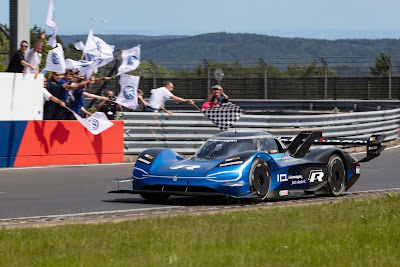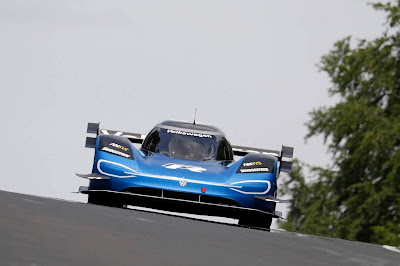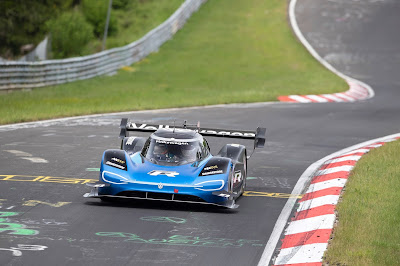Regenerative braking, in other words energy recovery when decelerating, greatly boosts the range of any electric vehicle. However, what should happen when drivers of electric vehicles take their foot off the right-most pedal is a difficult, philosophical question. Should the electric drive motor act as a generator, converting kinetic energy into electrical energy, or should it run without generating electrical energy, so that the vehicle’s momentum is used for coasting?
The answers to these questions vary greatly depending on the manufacturer and model. Some electric vehicles recover energy whenever a driver lifts off the right-most pedal after acceleration. In the case of the new ID.4 electric compact SUV, Volkswagen opted for a different strategy: coasting takes priority because conversion of energy inevitably leads to losses. This applies to the D (Drive) position, the default mode, which is automatically activated upon start-up.
The coasting function, whereby drivers take their foot off the accelerator pedal early on, makes for relaxed and predictable driving. Should drivers want to decelerate more, they step on the brake pedal and activate brake energy recuperation. During the majority of everyday braking maneuvers—up to around 0.25 g of deceleration—the electric drive motor performs the braking alone, while the electric brake servo only activates the friction brakes in situations that demand more stopping power. The transition from generator-based to hydraulic braking goes almost unnoticed, thanks to highly accurate and swift brake and drive system control. These systems also make sure that the rear wheels, where brake energy recuperation takes place, always have a sufficient amount of grip.
Each ID.4 features predictive Eco Assistance as standard. It analyzes data from the navigation system and vehicle sensors to provide drivers with effective support in driving efficiently and in a relaxed way. Once the ID.4 approaches a low-speed area, such as urban environments, junctions and bends, Eco Assistance notifies drivers to take their foot off the accelerator pedal. From this moment on, the system manages optimum coasting and energy recovery without drivers having to intervene. The car responds similarly when it approaches a vehicle ahead that is travelling at a lower speed.
Drivers can use the gear selector rocker switch to change from the D position to B (Brake) at any time. In this mode, the ID.4’s drive almost always recovers energy during lifting off, but not all the way to a standstill. The limit has been set at 0.13 g—enough for clearly noticeable deceleration that won’t confuse drivers of conventional internal combustion engine vehicles: intuitive operation is one of the vehicles’ greatest strengths.
The ID.4 is Volkswagen’s first all-electric SUV and the brand’s first electric world car. It offers sporty yet comfortable driving, a spacious interior and cutting-edge controls, displays, infotainment and assist systems. At launch in the U.S., the vehicle will be offered with an 82kWh (gross) battery and a rear-mounted AC permanent-magnet synchronous motor with 201 horsepower, 228 pound-feet of torque and an EPA-estimated 250 miles of range. A powerful, electric all-wheel-drive variant with 302 hp will follow later in 2021.








 For the past 50 years, the German auto industry has enjoyed quite the roll of growth and success in the U.S., built largely on its expertise with one specific technology: the internal combustion engine. But now the importance of that advantage is fading, with electric cars on the rise and the highest-value component within them the battery pack...
For the past 50 years, the German auto industry has enjoyed quite the roll of growth and success in the U.S., built largely on its expertise with one specific technology: the internal combustion engine. But now the importance of that advantage is fading, with electric cars on the rise and the highest-value component within them the battery pack... 
 As soon as 2024, electric cars are expected to reach price parity with gas-powered cars, largely due to the falling costs of battery packs. Volkswagen’s chairman Hans Dieter Pötsch, earlier this week, provided some commentary to the German Welt am Sonntag that appears to be aimed at dispelling that expectation—or at least lowering...
As soon as 2024, electric cars are expected to reach price parity with gas-powered cars, largely due to the falling costs of battery packs. Volkswagen’s chairman Hans Dieter Pötsch, earlier this week, provided some commentary to the German Welt am Sonntag that appears to be aimed at dispelling that expectation—or at least lowering... 
 Automakers face some daunting challenges in selling electric vehicles to urban apartment-dwellers, who are often without a home charging point. As a partial response, Volkswagen has shown a portable DC fast charging unit aimed at urban environments or temporary use at events or in parking lots—and it could be a very useful part of a strategy...
Automakers face some daunting challenges in selling electric vehicles to urban apartment-dwellers, who are often without a home charging point. As a partial response, Volkswagen has shown a portable DC fast charging unit aimed at urban environments or temporary use at events or in parking lots—and it could be a very useful part of a strategy... 
 Daimler, the parent company of Mercedes-Benz, last week revealed that it will be buying $23 billion in battery cells by 2030. What it didn’t fully reveal—its sources for those cells—says as much, if not more about a point of unease among German automakers. Battery packs—and specifically the cells inside—are the single...
Daimler, the parent company of Mercedes-Benz, last week revealed that it will be buying $23 billion in battery cells by 2030. What it didn’t fully reveal—its sources for those cells—says as much, if not more about a point of unease among German automakers. Battery packs—and specifically the cells inside—are the single... 
 Audi has recently released several hints that we’ll soon see a first concept tease of its smaller, more affordable electric vehicle, to be built on Volkswagen’s modular electric-vehicle architecture, termed MEB. And secondly, the Volkswagen brand is also soon expected to give a first look of how far upscale it can go with MEB. To the...
Audi has recently released several hints that we’ll soon see a first concept tease of its smaller, more affordable electric vehicle, to be built on Volkswagen’s modular electric-vehicle architecture, termed MEB. And secondly, the Volkswagen brand is also soon expected to give a first look of how far upscale it can go with MEB. To the... 
 Toyota announced pricing for the new 2019 Prius AWD-e. In trade talks with the Trump administration, VW's CEO revealed the company could use Ford factories in the U.S. to build new models—which could include electric cars. Rioters in France this month won what they wanted: a reprieve from higher gas taxes meant to reduce climate change. And...
Toyota announced pricing for the new 2019 Prius AWD-e. In trade talks with the Trump administration, VW's CEO revealed the company could use Ford factories in the U.S. to build new models—which could include electric cars. Rioters in France this month won what they wanted: a reprieve from higher gas taxes meant to reduce climate change. And... 
![Steve and Janet Wozniak with new 2016 Tesla Model S, December 2016 [source: Steve Wozniak Facebook]](https://images.hgmsites.net/tmb/steve-and-janet-wozniak-with-new-2016-tesla-model-s-december-2016-source-steve-wozniak-facebook_100585658_t.gif) Nissan announced it planned to remove Chairman Carlos Ghosn after an investigation revealed alleged financial misdealing. VW has no fun trademarking names for its new series of I.D. electric cars. The EPA plans to tighten emissions rules on heavy trucks. And cross-lawsuits reveal the underlying machinations in the Faraday Future saga. All this and...
Nissan announced it planned to remove Chairman Carlos Ghosn after an investigation revealed alleged financial misdealing. VW has no fun trademarking names for its new series of I.D. electric cars. The EPA plans to tighten emissions rules on heavy trucks. And cross-lawsuits reveal the underlying machinations in the Faraday Future saga. All this and...